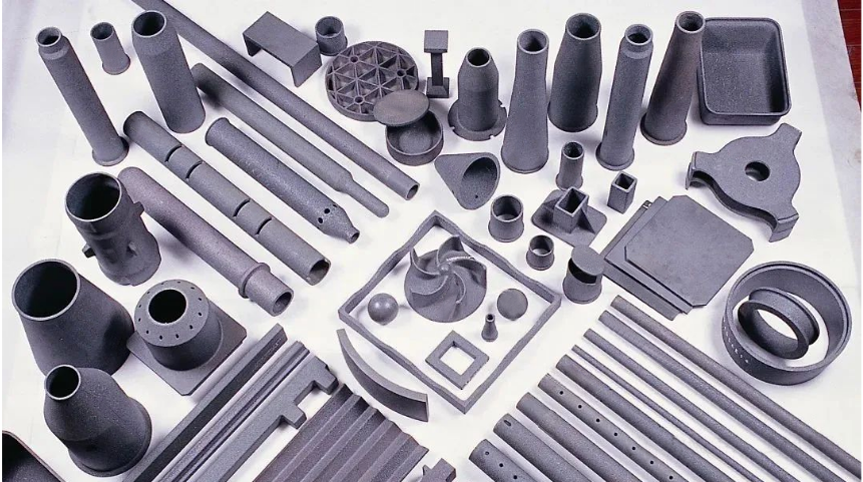Recrystallized silicon carbide (RSiC) ceramics are a high-performance ceramic material. Due to its excellent high temperature resistance, oxidation resistance, corrosion resistance and high hardness, it has been widely used in many fields, such as semiconductor manufacturing, photovoltaic industry, high temperature furnaces and chemical equipment. With the increasing demand for high-performance materials in modern industry, the research and development of recrystallized silicon carbide ceramics is deepening.
1. Preparation technology of recrystallized silicon carbide ceramics
The preparation technology of recrystallized silicon carbide ceramics mainly includes two methods: powder sintering and vapor deposition (CVD). Among them, the powder sintering method is to sinter silicon carbide powder under high temperature environment so that silicon carbide particles form a dense structure through diffusion and recrystallization between grains. The vapor deposition method is to deposit silicon carbide on the surface of the substrate through a chemical vapor reaction at high temperature, thereby forming a high-purity silicon carbide film or structural parts. These two technologies have their own advantages. The powder sintering method is suitable for large-scale production and has low cost, while the vapor deposition method can provide higher purity and denser structure, and is widely used in the semiconductor field.
2. Material properties of recrystallized silicon carbide ceramics
The outstanding characteristic of recrystallized silicon carbide ceramics is its excellent performance in high temperature environments. The melting point of this material is as high as 2700°C, and it has good mechanical strength at high temperatures. In addition, recrystallized silicon carbide also has excellent oxidation resistance and corrosion resistance, and can remain stable in extreme chemical environments. Therefore, RSiC ceramics have been widely used in the fields of high-temperature furnaces, high-temperature refractory materials, and chemical equipment.
In addition, recrystallized silicon carbide has a high thermal conductivity and can effectively conduct heat, which makes it have important application value in MOCVD reactors and heat treatment equipment in semiconductor wafer manufacturing. Its high thermal conductivity and thermal shock resistance ensure the reliable operation of the equipment under extreme conditions.
3. Application fields of recrystallized silicon carbide ceramics
Semiconductor manufacturing: In the semiconductor industry, recrystallized silicon carbide ceramics are used to manufacture substrates and supports in MOCVD reactors. Due to its high temperature resistance, corrosion resistance, and high thermal conductivity, RSiC materials can maintain stable performance in complex chemical reaction environments, ensuring the quality and yield of semiconductor wafers.
Photovoltaic industry: In the photovoltaic industry, RSiC is used to manufacture the support structure of crystal growth equipment. Since crystal growth needs to be carried out at high temperature during the manufacturing process of photovoltaic cells, the heat resistance of recrystallized silicon carbide ensures the long-term stable operation of the equipment.
High-temperature furnaces: RSiC ceramics are also widely used in high-temperature furnaces, such as linings and components of vacuum furnaces, melting furnaces and other equipment. Its thermal shock resistance and oxidation resistance make it one of the irreplaceable materials in high-temperature industries.
4. Research direction of recrystallized silicon carbide ceramics
With the growing demand for high-performance materials, the research direction of recrystallized silicon carbide ceramics has gradually become clear. Future research will focus on the following aspects:
Improving material purity: In order to meet higher purity requirements in the semiconductor and photovoltaic fields, researchers are exploring ways to improve the purity of RSiC by improving vapor deposition technology or introducing new raw materials, thereby enhancing its application value in these high-tech fields.
Optimizing microstructure: By controlling the sintering conditions and the distribution of powder particles, the microstructure of recrystallized silicon carbide can be further optimized, thereby improving its mechanical properties and thermal shock resistance.
Functional composite materials: In order to adapt to more complex use environments, researchers are trying to combine RSiC with other materials to develop composite materials with multifunctional properties, such as recrystallized silicon carbide-based composite materials with higher wear resistance and electrical conductivity.
5. Conclusion
As a high-performance material, recrystallized silicon carbide ceramics have been widely used in many fields due to their excellent properties in high temperature, oxidation resistance and corrosion resistance. Future research will focus on improving material purity, optimizing microstructure and developing composite functional materials to meet the growing industrial needs. Through these technological innovations, recrystallized silicon carbide ceramics are expected to play a greater role in more high-tech fields.
Post time: Oct-24-2024

